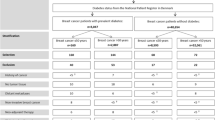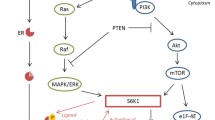Abstract
Purpose
Diabetes Mellitus (DM) has been one of the well known risk factors of breast cancer (BC) development and also associated with adverse clinical outcomes of BC patients. Glucagon-like peptide-1 (GLP-1) receptor agonists have been used as antidiabetic therapeutic agents and recent epidemiological studies have reported their use to be correlated with increased BC risks. However, biological or pathological details have remained unknown. Therefore, in this study, we examined the status of GLP-1 receptor (GLP-1R) in BC with and without DM and correlated the findings with the clinicopathological factors of the patients to explore the possible involvement of GLP-1 in BC pathology.
Methods
We immunolocalized GLP-1R in cancer and adjacent non-pathological breast tissues in BC patients with DM (125 cases) and without DM (58 cases). We then compared the status of GLP-1R with that of fibroblast growth factor 7 (FGF7) and fibroblast growth factor receptor 2 (FGFR2), Ki-67 labeling index (Ki-67 LI) and disease free survival (DFS) of the patients and also between cancerous and non-pathological breast tissues.
Results
GLP-1R immunoreactivity was significantly higher (p = 0.044) in the patients with DM than without in carcinoma tissues. However, this was detected only in invasive carcinoma (p < 0.01) and not in non-invasive carcinoma nor non-pathological mammary glands. FGF7 was significantly correlated with the status of GLP-1R in BC (p = 0.045). In addition, in ER positive BC cases, those with GLP-1R positive status tended to have higher Ki-67 LI of more than 14% (p = 0.070).
Conclusion
These findings all demonstrated the possible association between GLP-1R status and biological features of BC, especially of invasive BC in DM patients.






Similar content being viewed by others
Data availability
The datasets generated during and/or analyzed during the current study are not publicly available due personal information protection but are available from the corresponding author on reasonable request.
Change history
04 October 2021
A Correction to this paper has been published: https://doi.org/10.1007/s10549-021-06380-8
References
Lindsey AT, Freddie B, Rebecca LS, Jacques F, Joannie L-T, Ahmedin J (2015) Global cancer statistics. 2012. CA 65:87–108. https://doi.org/10.3322/caac.21262
Ido W, Siegal S, Raphael C, Avraham K, Bella K (2005) Diabetes mellitus and breast cancer. Lancet Oncol 6:103–111. https://doi.org/10.1159/000152028
Larsson SC, Mantzoros CS, Wolk A (2007) Diabetes mellitus and risk of breast cancer: a meta-analysis. Int J Cancer 121:856–862. https://doi.org/10.1002/ijc.22717
Boyle P, Boniol M, Koechlin A, Robertson C, Valentini F, Coppens K, Fairley LL, Boniol M, Zheng T, Zhang Y, Pasterk M, Smans M, Curado MP, Mullie P, Gandini S, Bota M, Bolli GB, Rosenstock J, Autier P (2012) Diabetes and breast cancer risk: a meta-analysis. Brit J Cancer 107:1608–1617. https://doi.org/10.1038/bjc.2012.414
Zhao XB, Ren G (2016) Diabetes mellitus and prognosis in women with breast cancer. Medicine 95(49): https://doi.org/10.1097/md.0000000000005602
Schrauder MG, Fasching PA, Häberle L, Lux MP, Rauh C, Hein A, Bayer CM, Heusinger K, Hartmann A, Strehl JD, Wachter DL, Schulz-Wendtland R, Adamietz B, Beckmann MW, Loehberg CR (2011) Diabetes and prognosis in a breast cancer cohort. J Cancer Res Clin Oncol 137:975–983. https://doi.org/10.1007/s00432-010-0960-2
Erickson K, Patterson RE, Flatt SW, Natarajan L, Parker BA, Heath DD, Laughlin GA, Saquib N, Rock Cl L, Pierce JP (2011) Clinically defined type 2 diabetes mellitus and prognosis in early-stage breast cancer. J Clin Oncol 29(1):54–60. https://doi.org/10.1200/JCO.2010.29.3183
Hardefeldt PJ, Edirimanne S, Eslick GD (2012) Diabetes increases the risk of breast cancer: a meta-analysis. Endocrine-Relat Cancer 19:793–803. https://doi.org/10.1530/erc-12-0242
Candyce HK, Wendy YC, Bernard R, Michelle DH (2016) Weight, weight gain, and survival after breast cancer diagnosis. J Clin Oncol 23:1370–1378. https://doi.org/10.1200/jco.2005.01.079
Blonde L, Russell-Jones D (2009) The safety and efficacy of liraglutide with or without oral antidiabetic drug therapy in type 2 diabetes: an overview of the LEAD 1–5 studies Diabetes. Obes Metab 24:26–34. https://doi.org/10.1111/j.1463-1326.2009.01075.x
Seino Y, Yabe D (2013) Glucose-dependent insulinotropic polypeptide and glucagon-like peptide-1: Incretin actions beyond the pancreas. J Diabet Invest 4(2):108–130. https://doi.org/10.1111/jdi.12065
Pi-Sunyer X, Astrup A, Fujioka K, Greenway F, Halpern A, Krempf M, Lau DCW, Le-Roux CW, Violante OR, Jensen CB, Wilding JPH (2015) A randomized, controlled trial of 3.0 mg of liraglutide in weight management. N Engl J Med 373:11–22. https://doi.org/10.1056/nejmoa1411892
Elashoff M, Matveyenko AV, Gier B, Elashoff R, Butler PC (2011) Pancreatitis, pancreatic, and thyroid cancer with Glucagon-like peptide-1based therapies. Gastroenterology 141:150–156. https://doi.org/10.1053/j.gastro.2011.02.018
Koehler JA, Baggio LL, Yusta B, Longuet C, Rowland KJ, Cao X, Holland D, Brubaker PL, Drucker DJ (2015) GLP-1R Agonists Promote Normal and Neoplastic Intestinal Growth through Mechanisms Requiring Fgf7. Cell Metab 21:379–391. https://doi.org/10.1016/j.cmet.2015.02.005
Hicks BM, Yin H, Yu OHY, Pollak MN, Platt RW, Azoulay L (2016) Glucagon-like peptide-1 analogues and risk of breast cancer in women with type 2 diabetes: population based cohort study using the UK Clinical Practice Research Datalink. BMJ 355:1–8. https://doi.org/10.1136/bmj.i5340
Araki E, Goto A, Kondo T, Noda M, Noto H, Origasa H, Osawa H, Taguchi A, Tanizawa Y, Tobe K, Yoshioka N (2020) Japanese clinical practice guideline for diabetes 2019. Diabetol Int 11:165–223. https://doi.org/10.1007/s13340-020-00439-5
Allison K, Hammond M, Hayes D, Dowsett M, Mckernin S, Carey L, Fitzgibbons P, Hayes D, Lakhani S, Chaves-MacGregor M, Perlmutter J, Perou C, Regan M, Rimm D, Symmans W, Torlakovic E, Varella L, Viale G, Weisberg T, McShane L, Wolff A (2020) Estrogen and Progesterone Receptor Testing in Breast Cancer: ASCO/CAP Guideline Update. J Clin Oncol 38(12):1346–1366. https://doi.org/10.1200/JCO.19.02309
Song Y, Zhou M, Cao Y, Qi J, Geng J, Liu X (2017) Expression of GLP-1 receptor and CD26 in human thyroid C-cells: The association of thyroid C-cell tumorigenesis with incretin-based medicine. Oncol Lett 13:2684–2690. https://doi.org/10.3892/ol.2017.5752
Sun S, Jiang Y, Zhang G, Song H, Zhang X, Zhang Y, Liang X, Sun Q, Pang D (2012) Increased expression of fibroblastic growth factor receptor 2 is correlated with poor prognosis in patients with breast cancer. J Surg Oncol 105:773–779. https://doi.org/10.1002/jso.22120
Fan EW, Li C-C, Wu W-J, Huang C-N, Li W-M, Ke H-L, Yeh H-C, Wu T-F, Liang P-I, Ma L-J, Li C-F (2015) FGF7 Over Expression is an Independent Prognosticator in Patients with Urothelial Carcinoma of the Upper Urinary Tract and Bladder. J Urol 194:223–229. https://doi.org/10.1016/j.juro.2015.01.073
Goldhirsch A, Wood WC, Coates AS, Gelber RD, Thürlimann B, Senn HJ (2011) Strategies for subtypes-dealing with the diversity of breast cancer: Highlights of the St Gallen international expert consensus on the primary therapy of early breast cancer 2011. Ann Oncol 22:1736–1747. https://doi.org/10.1093/annonc/mdr304
Ahrén B, Schmitz O (2004) GLP-1 receptor agonists and DPP-4 inhibitors in the treatment of type 2 diabetes. Horm Metab Res 36(11–12):867–876. https://doi.org/10.1055/s-2004-826178
Calanna S, Christensen M, Holst JJ, Laferrère B, Gluud LL, Vilsbøll T, Knop FK (2013) Secretion of glucagon-like peptide-1 in patients with type 2 diabetes mellitus: Systematic review and meta-analyses of clinical studies. Diabetologia 56(5):965–972. https://doi.org/10.1007/s00125-013-2841-0
Yamaoka TM, Tojo T, Takahira N, Matsunaga A, Aoyama N, Masuda T, Izumi T (2010) Elevated circulating levels of an incretin hormone, glucagon-like peptide-1, are associated with metabolic components in high-risk patients with cardiovascular disease. Cardiovasc Diabetol 9:1–9. https://doi.org/10.1186/1475-2840-9-17
Kanda R, Hiraike H, Wada-Hiraike O, Ichinose T, Nagasaka K, Sasajima Y, Ryo E, Fujii T, Osuga Y, Ayabe T (2018) Expression of the glucagon-like peptide-1 receptor and its role in regulating autophagy in endometrial cancer. BMC Cancer 18(1):657. https://doi.org/10.1186/s12885-018-4570-8
Ligumsky H, Wolf I, Israeli S, Haimsohn M, Ferber S, Karasik A, Kaufman B, Rubinek T (2012) The peptide-hormone glucagon-like peptide-1 activates cAMP and inhibits growth of breast cancer cells. Breast Cancer Res Treat 132(2):449–461. https://doi.org/10.1007/s10549-011-1585-0
Pyke C, Heller RS, Kirk RK, Ørskov C, Reedtz-RS Kaastrup P, Hvelplund A, Bardram L, Calatayud D, Knudsen LB (2014) GLP-1 receptor localization in monkey and human tissue: novel distribution revealed with extensively validated monoclonal antibody. Endocrinology 155(4):1280–1290. https://doi.org/10.1210/en.2013-1934
Seino Y, Yabe D (2011) Two incretin hormones GLP-1 and GIP: Comparison of their actions in insulin secretion and β cell preservation. Progress Biophys Mol Biol 107:248–256. https://doi.org/10.1016/j.pbiomolbio.2011.07.010
Palmieri C, Roberts-Clark D, Assadi-Sabet A, Coope RC, O’Hare M, Sunters A, Hanby A, Slade MJ, Gomm JJ, Lam EWF, Coombes RC (2003) Fibroblast growth factor 7, secreted by breast fibroblasts, is an interleukin-1 -induced paracrine growth factor for human breast cells. J Endocrinol 77:65–81. https://doi.org/10.1677/joe.0.1770065
Tannheimer SL, Rehemtulla A, Ethier SP (2000) Characterization of fibroblast growth factor receptor 2 overexpression in the human breast cancer cell line SUM-52PE. Breast Cancer Res 2:311–320. https://doi.org/10.1186/bcr73
Lei H, Deng CX (2017) Fibroblast growth factor receptor 2 Signaling in Breast Cancer Haipeng Lei and Chu-Xia Deng. Int J Biol Sci 13(9):1163–1171
Kim S, Dubrovska A, Salamone RJ, Walker JR, Grandinetti KB, Bonamy GM, Orth AP, Elliott J, Porta DG, Garcia-Echeverria C, Reddy VA (2013) FGFR2 promotes breast tumorigenicity through maintenance of breast tumor-initiating cells. PLoS ONE 8(1):e51671
Cui F, Wu D, Wang W, He X, Wang M (2016) Variants of FGFR2 and their associations with breast cancer risk: a HUGE systematic review and meta-analysis. Breast Cancer Res Treat 155:313–335. https://doi.org/10.1007/s10549-015-3670-2
Zang XP, Pento JT (2000) Keratinocyte growth factor-induced motility of breast cancer cells. Clin Exp Metastasis 18(7):573–580. https://doi.org/10.1023/A:1011997317994
Wu XY, Xu H, Wu ZF, Chen C, Liu JY, Wu GN, Yao XQ, Liu FK, Li G, Shen L (2015) Formononetin, a novel FGFR2 inhibitor, potently inhibits angiogenesis and tumor growth in preclinical models. Oncotarget 6(42):44563–44578. https://doi.org/10.18632/oncotarget.6310
Eiro N, Cid S, Fraile M, Cabrera JR, Gonzalez LO, Vizoso FJ (2020) Analysis of the gene expression profile of stromal pro-tumor factors in cancer-associated fibroblasts from luminal breast carcinomas. Diagnostics (Basel) 10(11):865. https://doi.org/10.1023/a:1011997317994
Cichon M, Degnim A, Visscher D, Radisky D (2010) Microenvironmental Influences that Drive Progression from Benign Breast Disease to Invasive Breast Cancer. J Mammary Gland Biol Neoplasia 15:389–397. https://doi.org/10.1007/s10911-010-9195-8
Hu M, Yao J, Carroll D, Weremowicz S, Chen H, Carrasco D, Richardson A, Violette S, Nikolskaya T, Nikolsky Y, Bauerlein E, Hahn W, Gelman R, Allred C, Bissell M, Schnitt S, Polyak K (2008) Regulation of In Situ to Invasive Breast Carcinoma Transition. Cancer Cell 13(5):394–406. https://doi.org/10.1016/j.ccr.2008.03.007
Michels KB, Solomon CG, Hu FB, Rosner BA, Hankinson SE, Colditz GA, Manson JE (2003) Type 2 diabetes and subsequent incidence of breast cancer in the nurses’ health study. Diabetes Care 26:1752–1758. https://doi.org/10.2337/diacare.26.6.1752
Turczyk L, Kitowska K, Mieszkowska M, Mieczkowski K, Czaplinska D, Piasecka D, Kordek R, Skladanowski AC, Potemski P, Romanska HM, Sadej R (2017) FGFR2-driven signaling counteracts tamoxifen effect on ERα-positive breast cancer cells. Neoplasia 19:791–804. https://doi.org/10.1016/j.neo.2017.07.006
Funding
This study did not receive any financial support.
Author information
Authors and Affiliations
Contributions
NHT and HS devised the project and the main conceptual ideas. NHT worked out almost all of the experiments and performed the analysis. SK and KT supervised the evaluation of immunohistochemistry. EI, YM, SK, KT interpreted the pathological results. SK and HS supervised the pathological examinations. NT and TI managed and provided the clinical data. YK, KU, SeT, ShT, NT, AK, and MM collected clinical data, selected appropriate cases, and evaluated the results. NT, TI, and HS interpreted and supervised the all results. NHT wrote the draft manuscript. YM, TK, NT, and HS reviewed and edited the manuscript. All authors discussed the results and commented on the manuscript.
Corresponding author
Ethics declarations
Conflicts of interest
There are no conflicts of interest that needs to be disclosed.
Consent to participate
Informed consent was obtained from all participants.
Consent for publication
It was included in the approval of the Tohoku University Ethics Committee.
Ethical approval
Research protocols of this study were approved by the Ethical Committee of Tohoku University School of Medicine (no.2018-1-433) and Nahanishi Clinic (no. NNCEC2017007) Japan.
Additional information
Publisher's Note
Springer Nature remains neutral with regard to jurisdictional claims in published maps and institutional affiliations.
Rights and permissions
About this article
Cite this article
Hashimoto Takigami, N., Kuniyoshi, S., Miki, Y. et al. Breast Cancer, Diabetes Mellitus and Glucagon-Like Peptide-1 Receptor Toward Exploring Their Possible Associations. Breast Cancer Res Treat 189, 39–48 (2021). https://doi.org/10.1007/s10549-021-06288-3
Received:
Accepted:
Published:
Issue Date:
DOI: https://doi.org/10.1007/s10549-021-06288-3




